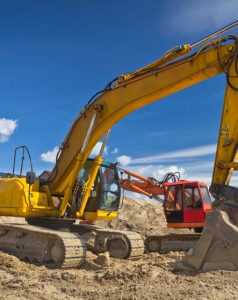Safety Practices to Implement When Using Heavy Machinery
 With the sun’s rise, construction sites bustle into activity as powerful engines roar to life, commanding respect from all on-site personnel. Burly cranes, colossal excavators, and daunting bulldozers breathe life into architectural blueprints, demonstrating the unstoppable might of man-made powerhouses.
With the sun’s rise, construction sites bustle into activity as powerful engines roar to life, commanding respect from all on-site personnel. Burly cranes, colossal excavators, and daunting bulldozers breathe life into architectural blueprints, demonstrating the unstoppable might of man-made powerhouses.
Yet, with immense power comes increased responsibility. The emphasis on safety while operating heavy machinery must be balanced, especially as the potential hazards grow proportionally with the size and complexity of the equipment. Here are some practices to ensure heavy equipment and machinery is used safely.
1. Regular Inspection and Maintenance
Comprehensive checks of machinery before and after usage are the bedrock of safety on construction sites. Regular inspections can help identify potential problems before they snowball into larger safety concerns. In the same vein as an athlete warming up before a game, machinery must be prepared for the day’s work, ensuring functionality and readiness for demanding labor.
The process of keeping construction equipment in great condition is a central pillar of safe operation. Regular maintenance extends the lifespan of machinery, but more critically, it significantly enhances safety on site. Equipment that needs to be adequately maintained is more prone to malfunction, endangering operators and site workers. Maintaining a strict maintenance schedule can catch wear and tear early, facilitating timely repairs and ensuring machines are always at their optimal performance.
2. Training and Certification
The best asset any construction worker can wield is knowledge – specifically, knowledge of proper machine operation. Comprehensive training programs and certification for heavy machinery operations are non-negotiables in construction safety. Certification ensures operators have the necessary skills and knowledge to handle the machinery safely and efficiently.
Training is not a one-off event but should be an ongoing process. Technological advancements introduce new machinery features, and operators need to stay informed. Regular refresher courses ensure that operators are up-to-date with the latest safety protocols and operation guidelines, equipping them with the knowledge to handle any situation they may face on the construction site.
3. Personal Protective Equipment (PPE)
Donning Personal Protective Equipment (PPE) is a simple but significant step in ensuring the safety of heavy machinery operators and other site workers. PPE such as hard hats, safety glasses, high-visibility clothing, steel-toe boots, and gloves can greatly reduce the risk of injury from machinery-related accidents.
Moreover, using PPE sends a powerful message about a company’s dedication to safety. It encourages a culture of caution and care, reminding everyone on the site of the importance of safety measures. Equipping employees with the right PPE and instilling a culture of its consistent use, therefore, can protect lives and maintain morale on the construction site.
4. Communication and Visibility
Clear communication is essential to avoid misunderstandings that could lead to serious accidents. This includes using established hand signals, radios, or air horns to communicate effectively across noisy sites. Operators should also know the importance of clarifying their intentions to other workers to avoid accidental collisions or mishaps.
Visibility is another critical aspect. The larger the machine, the more substantial the blind spots. Adequate lighting and the use of spotters can help overcome visibility challenges. Ensuring all machinery is equipped with working lights and reflectors, particularly during night-time operations or in poor weather conditions, can greatly enhance safety.
5. Adherence to Load Limits
Load limits are more than just numbers on a page. They are carefully calculated guidelines designed to prevent tipping, instability, or even the structural failure of machinery. Overloading equipment is a common cause of accidents on construction sites.
It is crucial for operators to understand these limits and to respect them rigorously. This understanding, combined with careful planning and execution of operations, can mitigate risks. Ignoring load limits puts machinery at risk but also jeopardizes the safety of everyone on the construction site.
6. Regular Breaks and Shift Rotations
Operating heavy machinery can be both physically and mentally exhausting. Long hours behind the controls can lead to fatigue, reduced alertness, and slower response times. Regular breaks and shift rotations help to ensure that operators remain alert and focused.
Fostering an environment where workers feel comfortable reporting fatigue or other health issues is also essential. Ensuring adequate rest and promoting the importance of self-care among workers is an investment in their well-being and the overall safety of the operation.
7. Emergency Preparedness
Having a comprehensive emergency response plan in place is essential. This should include provisions for first aid, fire safety, and evacuation procedures. Regular drills can ensure everyone on site knows what to do in an emergency. Additionally, all heavy machinery should have readily accessible and marked emergency shutdown procedures. These precautions can make the difference between a manageable incident and a catastrophic event, reinforcing the need for emergency preparedness.
8. Respect for Surroundings
Safety is also about respect for surroundings. Operators should be aware of the environmental implications of their actions. This includes correctly handling fuel and other potentially hazardous substances and understanding the machine’s impact on the local environment.
Moreover, understanding how to safely navigate the construction site, taking into account other activities and obstacles, is crucial. A holistic approach to safety that includes the wider environment and primary machinery operations will promote safer practices across the entire site.
In the end, while heavy machinery makes construction tasks easier and more efficient, the human element drives these machines. Therefore, a commitment to safety, training, and ongoing vigilance ensures that these tools are used to their fullest potential, without compromising the welfare of those who operate them.
Interested in receiving more great construction news, research and content from NCCER? Click here to join our mailing list!

